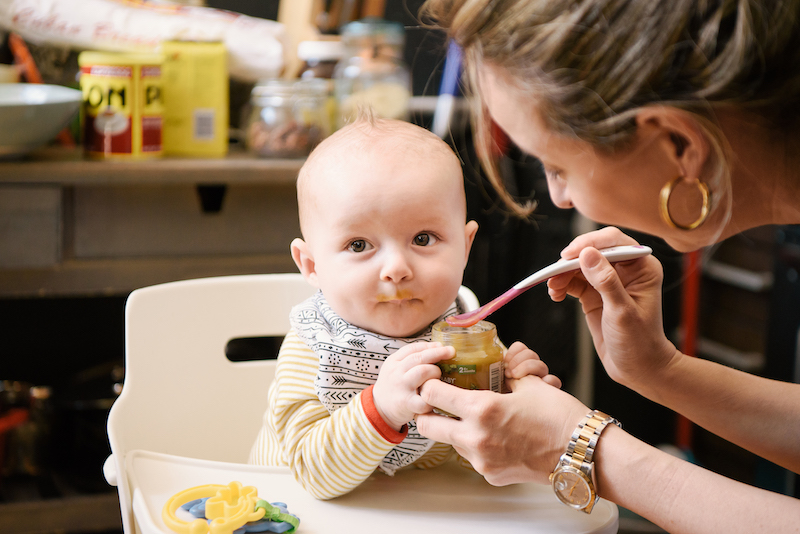Weaning is a process that begins whenever your baby begins to eat solid foods and/or take formula in addition to breastmilk. If your baby is around six months old, this process will happen naturally as you introduce solid foods, and it will also happen if or when you begin to supplement with or switch to formula.
A variety of factors can influence the decision to wean. Returning to work, starting a new medication that would be unsafe for your baby, societal or family pressures, feeling that your baby is “too old” or even becoming pregnant again! You can certainly do all of these things and still continue to pump and breastfeed in some form with a lot of help and support.
Regardless of the motivation, weaning is a personal decision for yourself and your child and one that hopefully you’ll be able to make without the pressure or influence of others. Take some time to carefully consider what you feel is best for you and your child when it comes to weaning. When the time comes, and assuming it is your decision and not your baby’s, weaning is best when done gradually, so that your body can produce less and less milk over time. As you decrease your nursing sessions, make sure your child is eating regular meals and snacks, and if they are under one year, breastmilk should be replaced with formula as cow’s milk is not adequate for infants under 12 months.
Mother-led or child-led weaning
When you begin to wean, the instigator will either be mama or baby. If you are leading the weaning process, you can either eliminate one feeding at a time every 3-7 days (starting with your baby’s “least favourite” feed), or you can shorten the length of each feed by a few minutes every few days until you’ve eliminated the feedings. With child-led weaning, your child will indicate they are ready by slowly decreasing the number and length of feedings on their own, usually over the course of a few months.
Weaning is a time of transition – both for you and baby
If you’re the one initiating weaning, your child may resist. It is not uncommon for toddlers who don’t want to wean to have tantrums or other outbursts. Quiet one-on-one time can help ease the transition. Your partner may wish to step in to help with calming and comforting or distracting your child. Just remember that your child may need some time to fully adjust.
Whether it is you or your child who is instigating weaning, you may feel sad or have a sense of loss over this changing relationship with your baby. Many moms feel a combination of nostalgia and relief, which can be confusing, not unlike other inevitable rites of passage. The shift of hormones that occurs in your own body during the weaning process is also thought to ignite a mother’s emotional response.
You’ll likely have a physical response as well. You may experience engorgement and related issues such as plugged ducts. Manually expressing just enough milk to make you comfortable again can provide some relief. Do not pump or express to the point of emptying your breasts if your goal is to stop breastfeeding. Or, if weaning is very gradual (as it often is when child-led), you may simply notice your breasts getting and staying smaller and your body returning to a solo physiologic and metabolic dance.
What to Do

- Wean when you and your baby decide the time is right
- Have a plan for how you’ll approach the process, but be flexible
- Decide who will lead the weaning process – you or your child. If you are taking the lead, allow your baby (and yourself!) time to adjust. Try to be patient and prepared for the possibility of pushback and irritability.
- Wean gradually unless it’s medically necessary for you to wean immediately
- Eliminate one feeding at a time or gradually shorten the length of each nursing session until it can be eliminated.
- Know when your child typically nurses and change your routine or schedule to offer distractions
- Sit or stand in places other than your typical nursing “spots.” And if your child still wakes at night to nurse, consider sleeping in another bed or another room.
- Set limits around breastfeeding, especially if your child is older than 18 months
- Let your child know that you will only be breastfeeding them at home or at certain times. If they are old enough, try offering a new toy or other surprise to celebrate their weaning.
- Avoid weaning during big life changes such as moving or starting day care
- If your breasts become painfully engorged, try expressing some milk to relieve the pressure and avoid the chances of getting plugged ducts
- Have a strong support network around you
Weaning can be an emotional time for both mom and baby. Try to keep busy with plans you can look forward to, whether it’s a fun activity with your child or a night out with your partner or friends.
Happy Family Organics Baby Clearly Crafted Jars are the perfect choice to introduce when you begin the weaning process. Filled with organic fruit and veggies, these jars are suitable for babies aged six months and up. Free from nasty preservatives and artificial ingredients and flavourants, they’re also extremely delicious, which helps a lot when you’re trying to convince baby to try something new.
Available at all Baby City stores, Babies R Us, Wellness Warehouse, Selected Clicks, Selected Spars, Selected Pick N Pay stores, Selected Baby Boom, selected Dis-Chem and selected Medicare pharmacies, and online from Takealot.com, Babiesafrica.com and Faithful to Nature
- Why vitamin D matters for babies, tots and mothers - April 25, 2023
- Why fiber is essential to every diet - April 19, 2023
- TRANSITIONING TO A NEW NAP PATTERN - March 8, 2021





